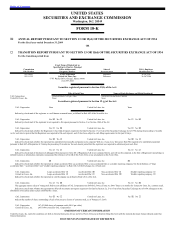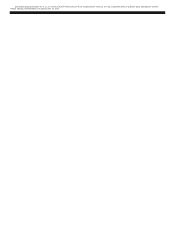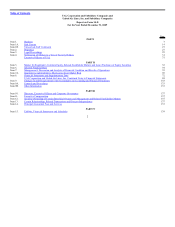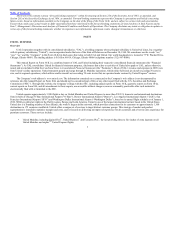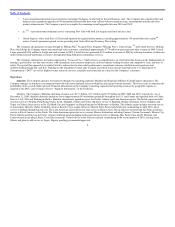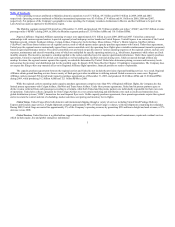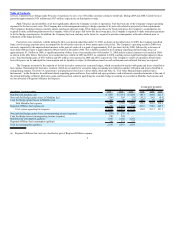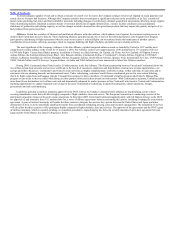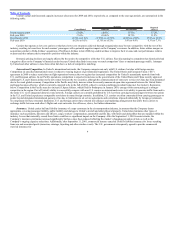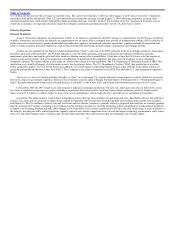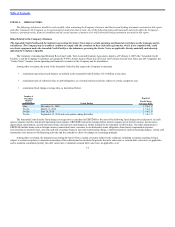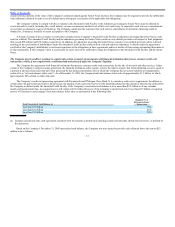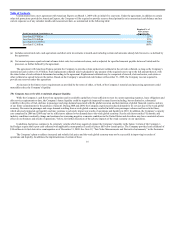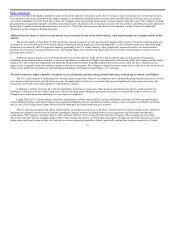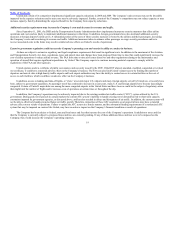United Airlines 2009 Annual Report Download - page 14
Download and view the complete annual report
Please find page 14 of the 2009 United Airlines annual report below. You can navigate through the pages in the report by either clicking on the pages listed below, or by using the keyword search tool below to find specific information within the annual report.
Table of Contents
U.S. airlines and has renewed this coverage on a periodic basis. The current war-risk policy is effective until August 31, 2010 and covers losses to employees,
passengers, third parties and aircraft. If the U.S. government does not extend this coverage beyond August 31, 2010, obtaining comparable coverage from
commercial underwriters could result in substantially higher premiums and more restrictive terms, if it is available at all. See “Increases in insurance costs or
reductions in insurance coverage may adversely impact the Company’s operations and financial results” in Item 1A, Risk Factors, below.
Industry Regulation
Domestic Regulation.
General. All carriers engaged in air transportation in the U.S. are subject to regulation by the DOT. Among its responsibilities, the DOT issues certificates
of public convenience and necessity for domestic air transportation (no air carrier, unless exempted, may provide air transportation without a DOT certificate of
public convenience and necessity), grants international route authorities, approves international codeshare agreements, regulates methods of competition and
enforces certain consumer protection regulations, such as those dealing with advertising, denied boarding compensation and baggage liability.
Airlines also are regulated by the Federal Aviation Administration (“FAA”), a division of the DOT, primarily in the areas of flight operations, maintenance
and other safety and technical matters. The FAA has authority to issue air carrier operating certificates and aircraft airworthiness certificates, prescribe
maintenance procedures and regulate pilot and other employee training, among other responsibilities. From time to time, the FAA issues rules that require air
carriers to take certain actions, such as the inspection or modification of aircraft and other equipment, that may cause the Company to incur substantial,
unplanned expenses. The airline industry is also subject to various other federal laws and regulations. The U.S. Department of Homeland Security (“DHS”) has
jurisdiction over virtually all aspects of civil aviation security. See Legislation, below. The U.S. Department of Justice (“DOJ”) has jurisdiction over certain
airline competition matters. The U.S. Postal Service has authority over certain aspects of the transportation of mail. Labor relations in the airline industry are
generally governed by the Railway Labor Act (“RLA”). The Company is also subject to inquiries by the DOT, FAA and other U.S. and international regulatory
bodies.
Airport Access. Access to landing and take-off rights, or “slots,” at several major U.S. airports and many foreign airports served by United are, or recently
have been, subject to government regulation. Domestic slot restrictions currently apply at Reagan National Airport in Washington D.C. (“Washington Reagan”),
John F. Kennedy International Airport and LaGuardia Airport (“LaGuardia”), both in New York, and Newark Liberty International Airport in New Jersey.
In December 2009, the DOT issued a new rule intended to enhance air passenger protections. The new rule, which goes into effect in April 2010, creates
new areas of regulation in passenger protection, including a requirement that certain carriers, including United, adopt contingency plans for lengthy tarmac
delays at most U.S. airports. A carrier’s failure to meet certain service performance criteria under the rule could subject it to substantial civil penalties.
Legislation. The airline industry is also subject to legislative activity that may have an impact on operations and costs. Specifically, the law that authorizes
federal excise taxes and fees assessed on airline tickets expired in September 2007 but has been extended multiple times and has most recently been extended
until March 31, 2010. In addition to federal, state and local taxes and fees that the Company is currently subject to, proposed taxes and fees are currently pending
that may increase the Company’s operating costs if imposed on the Company. Congress is currently attempting to pass comprehensive reauthorization legislation
to impose a new funding structure and make other changes to FAA operations. Past aviation reauthorization bills have affected a wide range of areas of interest to
the industry, including air traffic control operations, capacity control issues, airline competition issues, aircraft and airport technology requirements, safety issues,
taxes, fees and other funding sources. Congress may also pass other legislation that could increase labor and operating costs. Climate change
10


